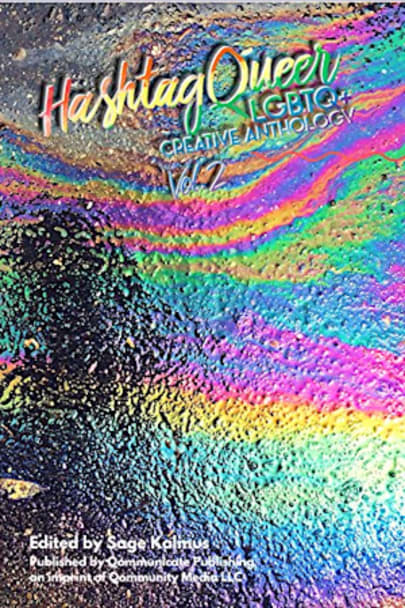The second volume of “Hashtag Queer: LGBTQ+ Creative Anthology” contains more fiction, more nonfiction, more poetry and more scripts by and about LGBTQ+. This volume welcomes back five writers from volume 1 and two writers from “Queer Families: A LGBTQ+ True Stories Anthology”. This volume also welcomes 20 new writers to the “Hashtag Queer” family.



Kudos for Hashtag Queer, Volume 2. I count myself lucky to have come across this compelling and generous anthology, wherein twenty-nine excellent writers and members of the LGBTQ+ community share their most personal thoughts and feelings. Thanks to them my appreciation for the depth and breadth of humanity is enlarged. Whether you are now a liberated, proud and resolute member of that community, or have yet to come out and let your queer flag fly, or are a straight but sympathetic ally such as myself, there is in this substantial and all-encompassing collection of stellar writing something for each of us.
Inside its pages, you will find seven works of fiction, five of non-fiction, three dramatic pieces and twenty-three poems expressing the entire spectrum of emotions around the existential quandary of being gay. As Editor Sage Kalmus reminds us: “…queer folks’ lives—like all lives—are a constant war between our best and worst selves.”
It is worth noting that each piece in this collection is original and never before published.
In the deftly rendered short fiction piece, Paul and Cezanne, by Andrew L. Huerta, a gay couple and their two adopted sons spend a few months in Paris where husband Sean has a bit part in a big-budget Hollywood movie. It is a rare opportunity for Sean to shine on the big screen. He is consumed with his work and debilitated by his crushing insecurity. Meanwhile, feeling abandoned and forsaken and helpless to encourage Sean, wife Paul wanders the streets of Paris and visits its many museums, especially the Musee de l’orangerie, where he becomes captivated by a work of Cezanne, the central figure of which reminds him of his tata, a courageous Freedom Fighter who survived the Mexican Revolution. Will Paul and Sean find the courage to keep their love alive?
Significantly, this story would have carried the same theme and had the same impact had the couple been straight…which speaks to the universality of the heart of humanity and echoes the words of Editor Kalmus: “Because even before we are queer, we are human, with all the good and bad, the sin and virtue that contains.”
In the non-fiction piece, Holy City, Cat Cotsell opines with caustic prose that the gains made by the LGBTQ+ community are inadequate and border on the hypocritical. “How proud everyone seems to be of themselves,” she laments. “Allies get to feel good for a while. They make our survival their achievement, while looking at me sideways and asking if I’m technically queer. They get to leave the party and return to their default human settings while we tidy up the beer glasses and walk home in pairs or groups.” She observes bitterly the commercialization of Gay Liberation: “I saw ads online selling polychromatic rings and flags and shirts, businesses getting their relevance on. I wanted to be happy about all the rainbows flooding my social media feed, but they were all ads trying to sell me to myself.” She concludes cynically that: “I should be grateful that my city is just vulgar, and not violent.”
The selection of poems in this anthology is engaging and diverse. In A Flame and a Whisper, Andrew Isaac Arthur speaks eloquently of what it is like to be young and seduced by a stranger on the road of life—specifically while hitchhiking through Holland, Michigan at tulip time—and the next day “to slip out of his car at the Interstate irrevocably the same person he picked up on a different highway the day before and undeniably someone new”.
In her poem Butter is not a Dress Susan Codair discovers that she breathes better in cargo shorts and a button-up than in a clingy dress of purple, blue and pink, butter-soft material.
In Threads, by Amy Reichbach, the narrator loses her grandmother and her father to cancer and is herself maimed, and hopes in fear and trepidation that her daughter will be the one to break the ravaging thread of disease.
In Richard Ballon’s brief but affecting script, Seeing Eye to Eye, we follow Joe, a straight white male who spent a few years in the joint for aggravated assault (read Gay Bashing), into a bar for a rendezvous with Ricardo, the victim of his assault. Joe has been urged by his sponsor to make amends. He discovers that forgiveness is a rare bird not easily caged, and that bitterness long abides in the hearts of the aggrieved.
And so much more there is to be found between the covers of Hashtag Queer Volume 2. “So, as you read all the exquisite and poignant words of these so generously vulnerable queer artists,” Editor Kalmus writes, “may they kindle within you a spark of unity with all who are so like and unlike you. And may this remind you that, while we may not be perfect…we are nonetheless inescapably one family and more alike than we are different.”
For the quality of its writing and its editing; for the range of its revelations; and for the courage of its publishers and its writers, I give this insightful and comprehensive collection Five Stars—and would that I could give it five more!